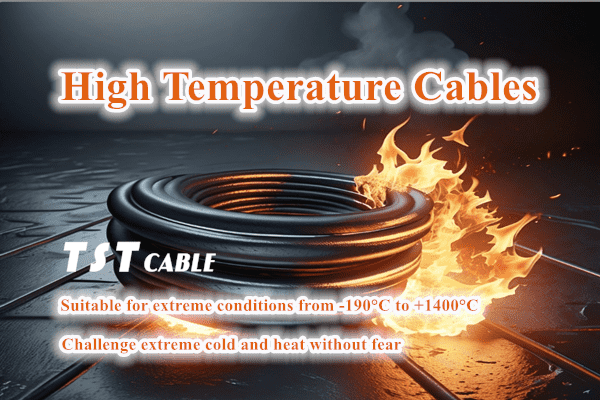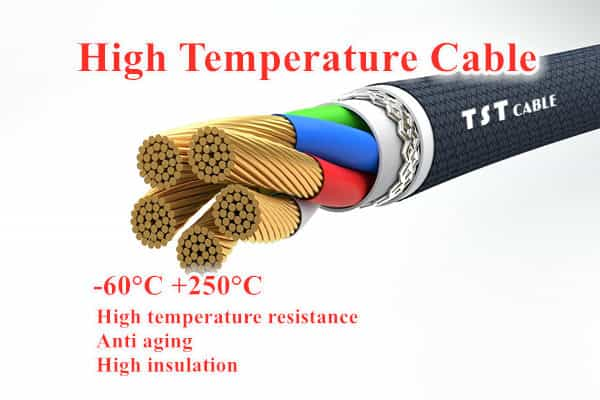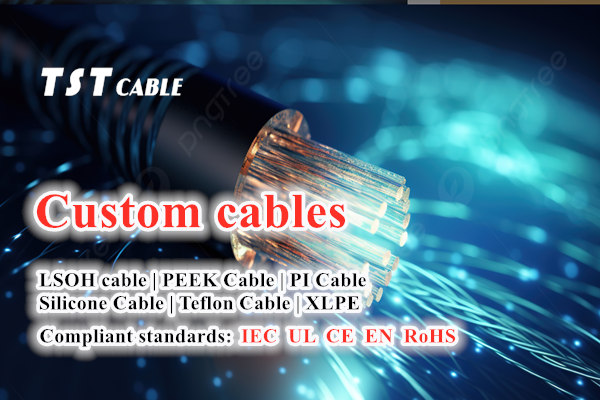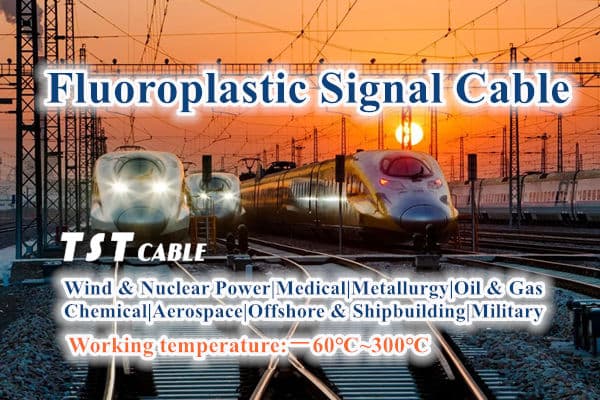70℃, 90℃, 105℃, 135℃, 250℃ high temperature cable and flame retardant control cable are a series of cable products classified according to the heat resistance level of their insulation materials. They are mainly used for control cables in AC rated voltage 450V/750V and below control, monitoring circuits and protection lines. Flame retardant control cable products have good flame retardancy, temperature resistance, corrosion resistance and aging resistance. They are mainly suitable for power supply and signal control lines in harsh environments and high temperatures such as chemical industry, thermal power plants and mines. In addition to having different temperature resistance, these cables also have flame retardant properties, which can delay the spread of fire when a fire occurs, and win precious time for personnel evacuation and emergency treatment.

Below TST cables will talk in detail about the characteristics and applications, technical indicators and technology development trends of cables with different temperature resistance levels.
1. Characteristics of cables with different temperature resistance levels
1. 70℃ high temperature flame retardant control cable
Application scope: Suitable for ordinary industrial control environments with low temperature requirements, such as light industrial equipment and household appliance control lines.
Features: The insulation material of the cable is limited to 70℃ in long-term working temperature, has basic flame retardant properties, and can meet general safety requirements.
2. 90℃ high temperature flame retardant control cable
Application scope: Widely used in control systems in medium temperature environments, such as mechanical equipment and building automation systems.
Features: Compared with the 70℃ level, its insulation material has stronger heat resistance, can work stably for a long time in a higher temperature environment, and its flame retardant performance is further improved, which is more suitable for more stringent application scenarios.
3. 105℃ high temperature flame retardant control cable
Application scope: Suitable for power and control systems in high temperature environments, such as heavy industrial fields such as metallurgy, chemical industry, and power plants.
Features: The insulation material has a temperature resistance upper limit of 105℃, can withstand higher working temperatures, has better heat aging resistance and a higher level of flame retardancy, ensuring safe operation in high temperature and potential fire risk occasions.
4. 135℃ high temperature flame retardant control cable
Application range: Especially suitable for special applications in extreme high temperature environments, such as aerospace, military equipment, nuclear power facilities, etc.
Features: Cables of this level use special high temperature resistant insulation materials, which can maintain stable operation under extremely harsh conditions, and have top flame retardant properties, ensuring that the continuity and safety of the circuit can be maintained under extremely high temperatures or special emergency conditions.
2. Common characteristics and precautions of high temperature flame retardant control cables
Flame retardant properties: All levels of cables have flame retardant properties, and are usually tested and graded according to the International Electrotechnical Commission (IEC) or national standards (such as China’s GB standards) to ensure that the spread of fire can be suppressed or delayed in the event of a fire.
Sheath and structure: The outer sheath of the cable is mostly made of PVC, PUR (polyurethane) or LSZH materials to adapt to different environmental requirements. The internal structure may include a multi-core design, which is suitable for a variety of signal transmissions.
Installation and maintenance: The maximum current carrying capacity and bending radius of the cable must be considered during installation to ensure heat dissipation and mechanical protection. Check the cable status regularly to prevent external damage from damaging the insulation layer.
3. Application fields of high temperature cables
1. Light industry and commercial buildings
70℃ flame-retardant control cable: suitable for relatively mild indoor environments such as air-conditioning systems, lighting control, and office equipment. Its economy and basic flame-retardant properties meet daily safety needs.
2. Industrial automation and process control
90℃ flame-retardant control cable: suitable for industrial applications with medium temperature and high current density such as automated production lines, robot control, and motor drive systems, ensuring stability and safety under continuous operation.
3. Heavy industry and infrastructure
105℃ flame-retardant control cable: in high-temperature operating environments such as metallurgy, petrochemicals, and power stations, as well as control systems in special environments such as rail transit and offshore platforms, cables are required to have higher temperature resistance and more reliable flame-retardant properties to cope with extreme conditions.
4. Special and extreme environments
135℃ flame-retardant control cable: for fields such as aerospace, military equipment, and nuclear power plants that have extremely strict requirements on cable performance, not only extremely high temperature resistance is required, but also cables are required to have excellent special properties such as radiation resistance and chemical corrosion resistance.
4. Key technical indicators of high-temperature cables
Working temperature range: This is one of the most basic indicators of high-temperature resistant cables, which defines the maximum allowable temperature of the cable under continuous or intermittent working conditions. For example, the continuous working temperature of some cables can be as high as 180°C, 200°C, 250°C or even higher.
Insulation material performance: High-temperature resistant cables usually use special materials as insulation layers, such as polyethersulfone cables (PES), polyetheretherketone (PEEK) cables, silicone rubber cables (Silicone Rubber), PI cables (polyimide), PE cables, PE (polyethylene cables), XLPE cables (cross-linked polyethylene), etc. These materials have excellent thermal stability, chemical stability and mechanical strength.
Flame retardant properties: High-temperature resistant cables often need to have flame retardant properties, that is, they can self-extinguish under fire conditions to prevent the spread of fire. The flame retardant grade is evaluated according to international standards such as UL, IEC, etc.
Conductor material: Copper or tinned copper is usually used as the conductor to ensure good conductivity and mechanical strength at high temperatures.
Outer sheath material: The outer sheath material must have properties such as high temperature resistance, chemical corrosion resistance, and wear resistance. Commonly used ones include fluoroplastics (such as PTFE, FEP), silicone rubber, etc.
Bending radius: The minimum allowable bending radius of high temperature resistant cables to ensure that the cables will not be damaged due to excessive bending during installation and use.
Oil resistance and solvent resistance: In some industrial environments, cables may come into contact with oils or solvents, so they need to have certain oil resistance and solvent resistance.
Mechanical strength: Including tensile strength, compressive strength, torsional strength, etc., to ensure that the cable can still maintain structural integrity when subjected to external forces.
Electrical properties: Including dielectric strength, resistivity, capacitance, insulation resistance, etc., to ensure that the cable can still maintain good electrical properties at high temperatures.
Environmental adaptability: High temperature resistant cables need to maintain stable performance in various harsh environments, such as UV resistance, salt spray resistance, mildew resistance, etc.
Service life: The expected service life of the cable under specified operating temperatures (70℃~1200℃) and conditions.
Standard compliance: High temperature resistant cables should comply with relevant international and national standards, such as IEC, UL, GB, etc., to ensure product quality and safety.
High temperature cable smoke density test: in accordance with the relevant provisions of GB12666.7-90
High temperature cable toxicity test: ≤2.5
High temperature cable voltage test: test voltage 3KV, time 5 minutes, no breakdown
High temperature cable flame retardancy test: passed GB/T18380.3-2001 type bundled combustion test
High temperature cable manufacturers need to strictly comply with the above technical indicators in the design and manufacture of high temperature cables to ensure the safe and reliable operation of the cables under high temperature and complex working conditions.
5. Models and names of high-temperature cables
ZR-KVV, ZR-KVV-105, ZR-KVV-135 copper core PVC insulated PVC sheathed flame-retardant control cable
ZR-KVVP, ZR-KVVP-105, ZR-KVVP-135 copper core PVC insulated PVC sheathed braided shielded flame-retardant control cable
ZR-KVVP2, ZR-KVVP2-105, ZR-KVVP2-135 copper core PVC insulated PVC sheathed copper tape shielded flame-retardant control cable
ZR-KVV22, ZR-KVV22-105, ZR-KVV22-135 copper core PVC insulated PVC sheathed steel tape armored flame-retardant control cable
ZR-KVVR, ZR-KVVR-105, ZR-KVVR-135 Copper core PVC insulated PVC sheathed flame retardant control soft cable
ZR-KVVRP, ZR-KVVRP-105, ZR-KVVRP-135 Copper core PVC insulated PVC sheathed braided shielded flame retardant control soft cable
ZR-KVVP22, ZR-KVVP22-105, ZR-KVVP22-135 Copper core PVC insulated PVC sheathed braided shielded steel belt armored flame retardant control cable
ZR-KVVP2-22, ZR-KVVP2-22-105, ZR-KVVP2-22-135 Copper core PVC insulated PVC sheathed copper belt shielded steel belt armored flame retardant control cable
VI. Safety and environmental protection requirements for high temperature cables with temperature resistance of 70℃, 90℃, 105℃, and 135℃
Flame retardant standards: Different countries and regions have different regulations on flame retardant grades, such as China’s GB/T 12666, EU IEC 60332, etc., to ensure that the cable can effectively suppress the spread of fire and protect the safety of personnel and property in the event of a fire.
Environmental protection trend: With the improvement of environmental awareness, the application of low-smoke halogen-free (LSZH) materials is becoming more and more widespread. Even high-temperature cables are turning to environmentally friendly materials to reduce toxic gas emissions during fires, in line with modern green buildings and sustainable development requirements.
VII. Future development and technological innovation of high-temperature cables
Intelligent monitoring: Integrated temperature sensing, fault warning and other functions enable cables to not only transmit signals and power, but also self-monitor, improving the efficiency and safety of system maintenance.
New material research and development: Continuously develop new insulation materials to improve the temperature resistance level while reducing weight, increasing flexibility, reducing costs, and improving environmental adaptability.
Environmental protection and sustainability: Explore more environmentally friendly production and recycling technologies, reduce carbon footprints in the production process, and promote the green transformation of the cable industry.
TST cables, the world’s leading high-temperature cable manufacturer
TST cables, a Chinese high-temperature cable manufacturer, reminds its customers that the selection and application of customized temperature-resistant cables (70℃, 90℃, 105℃, 135℃, 250℃, 260℃, 400℃, 900℃, 1000℃, 1100℃, 1200℃), high-temperature cables, flame-retardant control cables, not only concerns the matching of technical performance, but also needs to consider comprehensive factors such as the equipment’s operating temperature range, installation conditions and environment, transportation conditions, construction, after-sales, ecological environmental impact, safety regulations and future development trends, to ensure that while meeting the actual needs of the company at this stage and in the future, it also contributes to the sustainable development of human ecological environment protection.
TST cables high-temperature resistant cables use cutting-edge insulation technology to easily cope with the challenges of extreme high temperature environments of 70℃~1200℃. Excellent thermal stability and flame retardant properties protect your industrial heart. If you have any needs for high-temperature cables, please feel free to contact us by email or phone at any time to talk about your needs and confusions, and you can also get free proofing.
Also available in:
English




